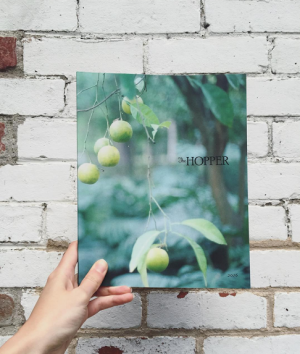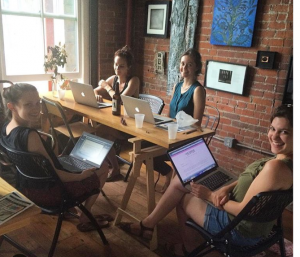The Hopper is a lively environmental literary magazine from Green Writers Press. The poetry, fiction, nonfiction, visual art, ecocriticism, and interviews that they publish are all paths towards an invigorated understanding of nature’s place in human life and are part of a new phase in nature writing and art that seeks to include a modern consciousness in narratives of place.
Having collaborated with Green Writers Press in interviews and Green Reads excerpts, I was happy to talk with one of the editors, Jenna Gersie, about their new magazine The Hopper.

Mary: The name The Hopper has a really cool background story behind it. Can you explain this, and the community spirit that harvesting fruit symbolizes with similarly mixing literary stories?
Jenna: The publication that preceded The Hopper was called Greenzine, which was a working title for a more DIY-style literary magazine from Green Writers Press. The name The Hopper came out of a poem by Leland Kinsey, who wrote often about the goings-on at his farm. Colloquially, there are “hoppers” of all sorts out there, but the most common understanding of it in Vermont is the part of the cider press where apples are tumbled through before getting pummeled.
Mary: The Hopper is environmental in nature, which is great. The magazine accepts poetry, fiction, nonfiction, visual art, ecocriticism, interviews, and book reviews, and hopes to be a leader in this cultural/natural world recentering. When did you open, and how is it going so far?
Jenna: We began publishing content online with the launch of our website in December 2015. Our first annual print issue was released in the spring of 2016. We’ve been steadily growing our audience since we first started publishing writers and artists, and our contributors have been an essential part of that growth by sharing The Hopper with their communities. With the growth in our audience has come an increase in submissions, and it is exciting to attract both new and established writers to our publication. We are proud to publish work on a variety of topics that show a wide range of human experiences in and connections with nonhuman nature.
Mary: What is your selection process for accepting work?
Jenna: We take care in reading each submission that we receive. Readers include our editors, Green Writers Press interns, and our publisher, Dede Cummings, as well as occasional volunteer readers. We collectively evaluate work on the quality of writing or art, originality, and how well the piece fits with our mission. We aim to publish work in all genres and on a variety of topics from a diverse group of writers and artists. Of the genres we publish, we receive the most poetry, so poetry selection is competitive.
Mary: Your affiliate, Green Writers Press, is a book publisher in Vermont, which has goals of relating—through literature—hope for a world currently enmeshed in a global climate crisis. How closely do the press and the magazine work together?

Jenna: Green Writers Press and The Hopper collaborate loosely in many ways. Several of our editors at The Hopper are also freelance editors for Green Writers Press, and Dede, the publisher and founder of Green Writers Press, helps us with many tasks, ranging from selecting content to designing our print magazine. Some of our writers, such as Brett Ann Stanciu, have been published both by Green Writers Press and The Hopper, and The Hopper published an interview with Green Writers Press author John Elder. Green Writers Press is also the publisher for the winner and runner-up of the 2016 Hopper Prize for Young Poets, John Saad and Ellene Glenn Moore. Much of the magic happens in Dede’s home office, but recent efforts have also come from Vermont, New Jersey, New Zealand, and The Bahamas, depending on where our editors are.
Mary: Sounds like a great venture (and adventure). Do you think that today’s writers are becoming more tuned in to the environment around us, and are they incorporating issues into their stories? In other words, is this a niche idea, or is there a trend?
Jenna: As Andrew Furman explores in his essay, “Summer Animals,” in our upcoming print issue, humans have been exploring their connections to nonhuman nature through art for as long as we can remember: from 35,000-year-old cave art to Thoreau’s Walden to work by contemporary writers and artists. In a time of environmental and climatic crisis, we believe that these expressions are both relevant and necessary and have the potential to inspire and motivate others to live more lightly and with more intention on our shared planet. Human connections to the environment are nothing new, but sharing these stories in new ways and from new perspectives in our digital age is exciting and enriching.
Mary: I am glad that you brought up that this work really goes back to the beginnings of human existence, which is something Jim Dwyer pointed out in his book Where the Wild Books Are: A Field Guide to Ecofiction. That it continues is very natural and essential. Thanks so much for the work your team does to promote this literature, and thank you, Jenna, for your time in talking with us!
For readers wanting to follow The Hopper, please see their Facebook, Twitter, and Instagram. The second annual print issue of The Hopper will be available later this spring.